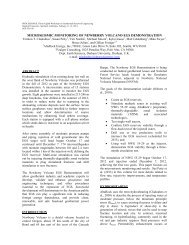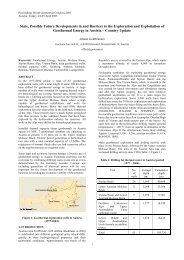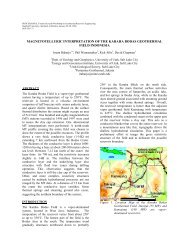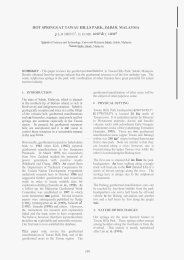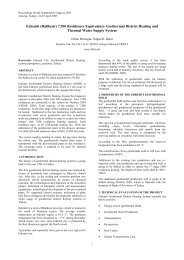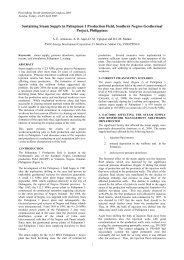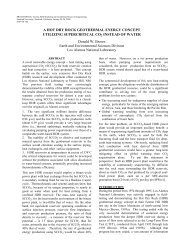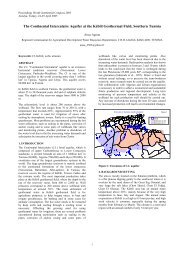The Iceland Deep Drilling Project - International Geothermal ...
The Iceland Deep Drilling Project - International Geothermal ...
The Iceland Deep Drilling Project - International Geothermal ...
Create successful ePaper yourself
Turn your PDF publications into a flip-book with our unique Google optimized e-Paper software.
Proceedings World <strong>Geothermal</strong> Congress 2005<br />
Antalya, Turkey, 24-29 April 2005<br />
<strong>The</strong> <strong>Iceland</strong> <strong>Deep</strong> <strong>Drilling</strong> <strong>Project</strong> –<br />
A Search for Unconventional (Supercritical) <strong>Geothermal</strong> Resources<br />
Gudmundur O. Fridleifsson*, Wilfred A. Elders**, Sverrir Thorhallsson* and Albert Albertsson***<br />
*ISOR (<strong>Iceland</strong> GeoSurvey), Grensasvegur 9, IS 108 Reykjavik, <strong>Iceland</strong>. **University of California, Riverside, CA 92521, USA.<br />
***Hitaveita Sudurnesja, Brekkustig 36, Reykjanesbæ, IS 260, <strong>Iceland</strong>.<br />
gof@isor.is, wilfred.elders@ucr.edu, s@isor.is, albert@hs.is<br />
Keywords: Supercritical fluids, unconventional geothermal<br />
resources, deep drilling, Reykjanes Ridge.<br />
ABSTRACT<br />
<strong>The</strong> <strong>Iceland</strong> <strong>Deep</strong> <strong>Drilling</strong> <strong>Project</strong> (IDDP) is a long-term<br />
program by an <strong>Iceland</strong>ic energy consortium to improve the<br />
economics of geothermal energy by producing supercritical<br />
hydrous fluids. A two year-long feasibility study was<br />
completed in June 2003 and in November of the same year<br />
a decision was reached to proceed, and to seek international<br />
funding for deep drilling from both the energy industry and<br />
from science foundations. <strong>Drilling</strong> of the first deep<br />
drillhole will begin early in 2005 in the Reykjanes hightemperature<br />
geothermal field, at a strategic site where the<br />
Mid-Atlantic Ridge emerges from the ocean. A 2.7 km deep<br />
well will be drilled, completed by a 12 ¼” rotary bit and left<br />
barefoot for flow testing. Funding for casing of the well, in<br />
summer 2006, and then rotary drilling from 2.7 km to 4.0<br />
km and subsequent flow testing, is being sought from the<br />
industry and international funding agencies. We plan to<br />
take several spot cores in this depth interval. After<br />
evaluation of the technical and scientific results from the<br />
4.0 km deep well, we plan to deepen the well to 5 km by<br />
core drilling into a supercritical geothermal reservoir and<br />
carry out a third flow test from that depth.<br />
<strong>The</strong> primary objective of IDDP is to find 450-600°C<br />
supercritical geothermal fluids at drillable depths, to study<br />
their physical and chemical nature and the feasibility and<br />
economics of using them as an energy source. Although<br />
drilling such deep wells will be expensive, modeling<br />
indicates that the power outputs from supercritical wells<br />
could be enhanced by a factor of 10 relative to the power<br />
production usual from high-temperature geothermal wells.<br />
This is because supercritical fluids have higher enthalpy<br />
than steam produced from two-phase systems and large<br />
changes in physical properties near the critical point can<br />
lead to extremely high flow rates. If this approach using<br />
such unconventional geothermal resources is an economic<br />
success the same approach could be applied in other hightemperature<br />
volcanic geothermal systems elsewhere, as an<br />
important step in enhancing the geothermal industry<br />
worldwide. <strong>The</strong> IDDP could serve as an ideal R&D<br />
platform for both a European and an international<br />
programme on sustainable energy from unconventional<br />
geothermal resources. This programme could integrate the<br />
generation of electric power, production of a clean energy<br />
carrier like hydrogen, possible production of chemicals in<br />
an environmentally sound way, and eco-tourism as part of<br />
the “Geopark” concept.<br />
1. INTRODUCTION<br />
Over the next several years the <strong>Iceland</strong> <strong>Deep</strong> <strong>Drilling</strong><br />
<strong>Project</strong>, IDDP, expects to drill and test a series of boreholes<br />
that will penetrate supercritical zones believed to be present<br />
beneath three currently exploited geothermal systems in<br />
<strong>Iceland</strong>, at Krafla, Nesjavellir and Reykjanes. This requires<br />
drilling to depths greater than 4 to 5 km, in order to produce<br />
hydrothermal fluids at temperatures of 450 to 600°C.<br />
<strong>Deep</strong> Vision is an <strong>Iceland</strong>ic energy consortium (Hitaveita<br />
Sudurnesja Ltd., Landsvirkjun, Orkuveita Reykjavikur and<br />
Orkustofnun) that began the IDDP in 2000. <strong>The</strong> principal<br />
aim is to enhance the economics of high temperature<br />
geothermal resources. A two-year feasibility study was<br />
completed in 2003, addressing basic questions such as: Can<br />
4-5 km deep and 450-600°C hot wells be drilled safely?<br />
Can they produce fluids? What will be the advantages and<br />
disadvantages and the overall economics? Where should the<br />
first IDDP well be drilled? <strong>The</strong> feasibility report is divided<br />
into three parts. Part 1 deals with geosciences and site<br />
selection (Fridleifsson et al., 2003a), Part 2 on drilling<br />
technique (Thorhallsson et al., 2003a), and Part 3 on fluid<br />
handling and evaluation (Albertsson et al., 2003a).<br />
From the outset <strong>Deep</strong> Vision has been receptive to<br />
including scientific studies in the IDDP (Fridleifsson and<br />
Albertsson, 2000). An international advisory group, SAGA,<br />
that has assisted <strong>Deep</strong> Vision with science and engineering<br />
planning of the IDDP, was established in 2001, with<br />
financial support from the <strong>International</strong> Continental<br />
Scientific <strong>Drilling</strong> Program (ICDP). <strong>The</strong> financial support<br />
was used to organize and discuss in detail drilling and<br />
scientific issues linked to IDDP. An IDDP/ICDP start-up<br />
meeting was held in Reykjavík in June 2001. This was<br />
followed by a workshop on drilling technique in March<br />
2002, and a science workshop in October 2002. Altogether<br />
some 160 participants from 12 nations participated in the<br />
workshops. <strong>The</strong> essence of these workshops and<br />
recommendations to IDDP are described in SAGA reports<br />
1, 2 and 3, respectively, all of which are available on the<br />
IDDP website (http://www.os.is/iddp/) and appended to the<br />
IDDP Feasibility Report (op.cit.). <strong>The</strong> IDDP/ICDP<br />
workshops and SAGA influenced the feasibility report<br />
considerably, and focused many aspects of its approach. A<br />
summary of the IDDP feasibility report and the<br />
international workshops was published in the proceedings<br />
of the <strong>International</strong> <strong>Geothermal</strong> Conference 2003<br />
(IGC2003) in Reykjavik (Albertsson et al. 2003b, Elders et<br />
al. 2003, Fridleifsson et al. 2003b,c, and Thorhallsson et al.<br />
2003b) and the Transactions of the <strong>Geothermal</strong> Resources<br />
Council meeting in 2003 (Fridleifsson and Elders, 2003).<br />
Two additional papers on this subject have been submitted<br />
to a special issue of the Geothermics (Fridleifsson and<br />
Elders, 2004; Thorhallsson et al. 2004).<br />
Among the chief findings of the feasibility report were:<br />
1) Each of the three target geothermal fields (Krafla,<br />
Nesjavellir and Reykjanes, Figure 1) has excellent potential<br />
drill sites to reach supercritical conditions.<br />
1
Fridleifsson G.O. et al.<br />
2) Wells producing from reservoir with supercritical fluids<br />
could have power output per well, increased by an order of<br />
magnitude, relative to conventional geothermal wells.<br />
3) An IDDP well to 5 km depth can be drilled using<br />
available technology.<br />
4) 400-600°C steam can be dealt with and would be much<br />
more valuable than lower temperature steam.<br />
at least partially cover the additional drilling costs incurred<br />
in obtaining 1.2 km of core during the first planned phase of<br />
coring from 2.5 to 3.7 km depth. This slimhole would then<br />
be reamed to production size hole, e.g. to 8 ½ inches<br />
diameter, followed by cementing of a 7 inch wide liner,<br />
before the DHCS system would be used to continue coring<br />
to 5 km.<br />
5) <strong>The</strong> fluid composition will not be known until after<br />
drilling.<br />
6) An IDDP production well 5 km deep would cost 8-9<br />
million USD.<br />
7) A full scale exploratory IDDP well, with extensive<br />
coring required by the science program would cost 14.4-<br />
15.5 million USD.<br />
8) A full scale flow test and pilot system for fluid<br />
evaluation would cost 5.5 million USD.<br />
Our modelling indicates that a ten-fold increase in power<br />
output per well, relative to that from conventional<br />
geothermal wells 2.5 km deep is likely if fluid is produced<br />
from reservoir hotter than 450°C. This is because<br />
supercritical fluids have very low viscosity and density, so<br />
that extremely high flow rates should be possible from such<br />
wells. A comparison with a conventional geothermal well is<br />
instructive. A conventional well that produces dry steam<br />
only, at a wellhead pressure of 25 bars a and a downhole<br />
pressure of 30 bars a will yield approximately 5 MW of<br />
electric power if the volumetric rate of outflow from the<br />
well is 0.67 m 3 s -1 . An IDDP well tapping a supercritical<br />
reservoir with temperatures of 430 – 550 °C and pressures<br />
of 230 - 260 bar may be expected to yield 50 MW of<br />
electric power given the same volumetric inflow rate<br />
(Albertsson et al. 2003a, b). <strong>Drilling</strong> deeper wells to test<br />
this unconventional geothermal resource would also allow<br />
testing of injecting cold water into fractured rock to sweep<br />
heat from a very hot reservoir. Experiments in permeability<br />
enhancement could also be conducted.<br />
Based on evaluation of the IDDP Feasibility Study in 2003,<br />
the energy consortium decided to proceed to select the<br />
location and design of the first exploratory wells and to<br />
seek international partners and funding. During that<br />
discussion one of the members of the <strong>Deep</strong> Vision<br />
consortium, Hitaveita Sudurnesja Ltd (HS), offered to allow<br />
IDDP to deepen one of their planned 2.5 km deep<br />
exploratory/production wells. It is located on the Reykjanes<br />
peninsula, where the Mid-Atlantic Ridges emerges from the<br />
ocean (Figure 1) and so is ideally located for scientific<br />
studies of the coupling of hydrothermal and magmatic<br />
systems on mid-ocean ridges. A comprehensive scientific<br />
program, involving investigators from more than 12<br />
different countries, is therefore planned to take advantage<br />
of this unparalleled research opportunity.<br />
<strong>The</strong> scientific studies require that as much drill core as<br />
possible, especially from the deeper part of the borehole in<br />
the supercritical zone. We plan to use the DOSECC Hybrid<br />
Coring System (DHCS) for coring that part of the well. <strong>The</strong><br />
DHCS uses a small diameter mining type core barrel, type<br />
HQ, hole diameter 3 7/8 inches. Our original plan was to<br />
use this system in two phases from 2.5 to 3.7 km in 2005<br />
and from 3.7 to 5.0 km in 2006. However coring is slower<br />
and more expensive than conventional drilling. <strong>The</strong>refore,<br />
we submitted a funding request to ICDP (<strong>International</strong><br />
Continental Scientific <strong>Drilling</strong> Program) in January 2004 to<br />
2<br />
Figure 1: <strong>The</strong> location of Reykjanes Peninsula on the<br />
Mid-Atlantic Ridge at the South West tip of <strong>Iceland</strong> and<br />
the three geothermal fields Reykjanes, Nesjavellir and<br />
Krafla that are potential sites to develop supercritical<br />
geothermal resources in <strong>Iceland</strong> .<br />
At the end of May 2004 the ICDP requested that the ICDP<br />
should clarify the scientific goals of the project and revise<br />
the work proposed in order to reduce the budget.<br />
Accordingly SAGA (Science Application Group of<br />
Advisors) of the IDDP, met with <strong>Deep</strong> Vision, the IDDP<br />
steering committee, and a number of international<br />
participants, on June 1 st and 2 nd . <strong>The</strong> report of this meeting,<br />
the 4 th SAGA report, is available at the http://www.iddp.is.<br />
At this meeting, a representative of the industrial<br />
consortium reaffirmed that it is only a matter of time before<br />
the industry drills much deeper into the high-temperature<br />
zones in <strong>Iceland</strong>. Given the uncertainties of the budget at<br />
the time of the preparation of this paper, drilling and coring<br />
plans were still under active discussion, so that the drilling<br />
plan discussed here will doubtless be modified and<br />
improved as the project develops. <strong>The</strong> modified drilling<br />
plan discussed here would yield fluid samples from flow<br />
tests at depths 2.7, 4.0 and 5.0 km depths; pressure,<br />
temperature and flow-meter logs over the whole drilled<br />
intervals; drill cuttings down to 4.0 km depth, including<br />
several spot cores from 2.7-4.0 km depth, and continuous<br />
drill cores from 4.0 to 5.0 km depth. This plan is technically<br />
challenging and therefore expensive. Few boreholes in the<br />
world have ever been drilled at temperatures of greater than<br />
400 o C.<br />
2. THE IDDP DRILLING PLAN<br />
Our cost sharing models are based on the assumptions that<br />
the industrial partners would finance the cost of an<br />
exploration or production well, whereas the additional<br />
operational costs incurred by the scientists, such as coring,<br />
etc., would be financed by the science program. This was<br />
reflected in the drilling proposal submitted to ICDP that
Fridleifsson G.O. et al.<br />
requested 4 million USD for continuous coring from 2.5 to<br />
3.7 km depth. This sum represents the cost difference<br />
between rotary drilling and continuous coring from 2.5 to<br />
3.7 km, plus the rig time necessary for specialized logging<br />
and fluid sampling for the science program and associated<br />
costs. <strong>The</strong> cost of drilling this hole from 2.5 to 3.7 km<br />
without coring, i.e. by conventional rotary drilling with an 8<br />
1/2 inch bit was estimated to be 3 million USD, whereas<br />
continuously coring that interval and cementing a 9 5/8”<br />
casing down to 2.5 km was nearly 7 million USD.<br />
<strong>The</strong> obvious way to reduce the incremental drilling costs<br />
for the science program is to reduce the amount of coring<br />
in a way that minimizes the negative impact on the science<br />
programme. <strong>The</strong> plan discussed here is such a compromise<br />
approach that emphasizes obtaining only the cores most<br />
vital to the science program.<br />
<strong>The</strong> coring options range from (i) complete wireline coring<br />
from the surface down, (ii) wireline coring below 2.5 km,<br />
(iii) spot coring during rotary drilling, to (iv) no coring at<br />
all. Option (i) is too expensive, and does not take<br />
advantage of the 2.5 km deep well being offered by<br />
industry. Option (ii) was the option that was presented in<br />
drilling proposal to ICDP. Option (iii) is expensive of<br />
drilling rig time because of the number of round trips<br />
necessary to retrieve a core barrel and resume drilling.<br />
Depending on the number of trips of the drill string, it is<br />
estimated that attempting a single 8 m long core deep down<br />
in the borehole could cost up to 100,000 USD. <strong>The</strong> last<br />
option (iv), however, is basically unacceptable to the<br />
current science program for the several reasons discussed<br />
below.<br />
2.1 <strong>The</strong> need for drill cores<br />
A major aim of the science program of the IDDP is to<br />
investigate the transition from subcritical to supercritical<br />
conditions in an active hydrothermal system, to determine<br />
pressures, temperatures, and fluid compositions and to gain<br />
insight into the physics and chemistry of the supercritical<br />
state in nature. To investigate the systematics of magmahydrothermal<br />
processes near critical conditions a major<br />
requirement is to obtain as much core as possible. Study of<br />
the coupling of the chemical and mineral alteration, fracture<br />
propagation, pressure solution, and fluid flow will be based<br />
on analysis of data on mineral chemistry, isotopes,<br />
geothermometry, and fracture geometry. More than half the<br />
science projects proposed to the IDDP would be impossible<br />
or severely compromised without drill core. Approximately<br />
60 science projects have been proposed to participate, in the<br />
IDDP by scientists from USA, Canada, <strong>Iceland</strong>, Germany,<br />
France, Italy, Russia, New Zealand and Japan<br />
<strong>The</strong> common practice in <strong>Iceland</strong> is to use downhole motors,<br />
for their high penetration rate while rotary drilling, and this<br />
produces very fine grained drill cuttings. Unraveling the<br />
nature and chronology of fracture failure and vein in-filling<br />
and detection of time serial fracture events and<br />
determination of constituitive rock properties requires core.<br />
Measurements of mechanical and thermal properties of core<br />
as a function of temperature are necessary to quantify<br />
processes related to brittle-ductile behaviour. <strong>The</strong><br />
permeability and thermal diffusivity of fractured and intact,<br />
fresh and altered, basalt comprise essential baseline<br />
information for fluid circulation models.<br />
Another compelling argument for coring is that due to high<br />
permeability, total loss of drilling fluid in geothermal<br />
reservoirs is often encountered in drilling <strong>Iceland</strong>ic<br />
geothermal wells. While lost circulation is probably the best<br />
3<br />
indicator of the high permeability, essential for geothermal<br />
exploitation, it prevents recovery of drill cuttings.<br />
Furthermore, high temperatures will preclude use of<br />
borehole televiewers, and many other logging tools. Thus<br />
drilling without core risks having no information on the<br />
strata penetrated. Coring is a part of all major scientific<br />
drilling projects today and the philosophy is that utilization<br />
of core will increase in the future as science progresses, as<br />
cores constitute a robust archival record.<br />
A final argument for coring is that their study during<br />
drilling will provide useful information to guide the drilling<br />
and casing operations in real time. Mixing subcritical with<br />
supercritical fluid during production could cause<br />
acidification by wettening the steam and thereby lead to<br />
corrosion or scaling of the well casings. This can be<br />
avoided by casing off the sub-critical zone. This requires<br />
recognizing when supercritical conditions are encountered<br />
during drilling and before flow testing. This will be done by<br />
studying mineral assemblages and fluid inclusions in cores<br />
in an on-site petrographic laboratory. However, once the<br />
physical conditions of the deep reservoirs studied are<br />
known, normal production wells could be drilled without<br />
coring.<br />
2.2 <strong>The</strong> drilling plan proposed in June 2004<br />
<strong>The</strong> current drilling plan proposed in June 2004 is shown in<br />
Figure 2 and Table 1. In this compromise approach only<br />
spot cores will be taken during rotary drilling at depths<br />
above 4 km, e.g. at bit changes, and continuous wireline<br />
coring will only be done deeper than 4.0 km, that is in the<br />
hotter part of the system, where supercritical conditions are<br />
most likely.<br />
Figure 2. An alternative drilling plan for the IDDP<br />
borehole in the Reykjanes geothermal system.<br />
<strong>The</strong> sequence of operations proposed is shown in Table 1<br />
and described below:-
Fridleifsson G.O. et al.<br />
Phase I – Pilot Phase (0-2.7 km) Rotary <strong>Drilling</strong>: In<br />
February 2005 Hitaveita Sudurnesja intends to complete a<br />
bare-foot production well 2.7 km deep with 13 3/8 inch<br />
production casing to 800 m. One or two 8 meter-long spot<br />
cores will be drilled at 2.7 km depth, and a full suite of logs,<br />
including specialized high-temperature tools, will be run. A<br />
full-scale flow test will carried out in August to October.<br />
<strong>The</strong> cost of drilling, logging and testing the 2.7 km deep<br />
well, estimated to be about 3 million USD, will be paid by<br />
Hitaveita Sudurnesja. <strong>The</strong> incremental operational cost of<br />
the science program in 2005 is estimated to ~150,000 USD<br />
(rig time for coring, specialized logging, fluid sampling,<br />
onsite laboratory, etc.)<br />
Table 1. Proposed work plan for an IDDP borehole at<br />
Reykjanes.<br />
DATE:<br />
Actions:<br />
2005 Rotary <strong>Drilling</strong> Logging<br />
Jan-Feb <strong>Drilling</strong> with 12 1/4" bit conventional<br />
0.0 - 2.7 km 0.8-2.7 km open hole plus high-T tools<br />
petrography & fluid -<br />
spot core at bottom inclusions & DIS<br />
Aug-October Flow test 1 conventional<br />
2006 Casing with 9 5/8" conventional<br />
Aug-October <strong>Drilling</strong> with 8 1/2" bit plus high-T tools<br />
2.7 - 4.0 km petrography & fluid -<br />
Core at bit changes inclusions & DIS<br />
Initial corestudy<br />
Dec-March Flow test 2 As applicable<br />
2007 Core drilling Logging<br />
Aug-October Casing with 7" HSDP-model<br />
Technical casing 5" for core handling<br />
4.0 - 5.0 Km DOSECC coring 3.8" bit<br />
Nov-Dec. Flow test 3 As applicable<br />
Phase 2-(2.7-4.0 km) Rotary <strong>Drilling</strong>. Starting in August-<br />
October 2006, 9 5/8 inch casing will be cemented to 2.7 km<br />
and rotary drilling commenced with an 8 1/2 inch bit down<br />
to 4.0 km. Spot cores will be taken at bit changes, and hightemperature<br />
logs run. A flow test of the open interval 2.7-<br />
4.0 km will be carried out between December 2006 and<br />
March 2007. <strong>The</strong> time for drilling from 2.7 to 4.0 km in<br />
Phase 2 is about 50 days. <strong>The</strong> cost of rotary drilling is<br />
estimated to be about 3.7 million USD. <strong>The</strong> incremental<br />
operational cost of the science program in 2006 (spot<br />
coring, sample handling, specialized logging, fluid<br />
sampling, field laboratory, etc.) is estimated to be in the<br />
range of 0.5 million USD.<br />
Phase 3 (4.0-5.0 km). Continuous Wireline Coring. Starting<br />
in August-October 2007, a 7-inch casing will be cemented<br />
to 4.0 km and wireline HQ drilling will start, through a 5-<br />
inch technical liner, using a mining type drilling rig (the<br />
DOSECC DHCS system). Coring from 4.0 to 5.0 km and<br />
testing, logging and downhole experiments would take<br />
about a hundred days and cost 5.5-6 million USD, which<br />
would be a charge to the science program in 2007, subject<br />
to negotiation with the energy consortium and possible<br />
international partners. A flow test from the cored hole of<br />
the interval below 4.0 km would also be attempted.<br />
3. POSSIBLE WIDER APPLICATIONS<br />
<strong>The</strong> IDDP needs international partners to participate in the<br />
high costs involved its research and development program,<br />
for scientific coring and the development and usage of the<br />
4<br />
prototype high-temperature logging and downhole sampling<br />
tools needed for the project.<br />
Today <strong>Iceland</strong> has the world’s highest ratio of renewable<br />
energy, as 67% of all primary energy used is either hydro or<br />
geothermal. This fraction could become larger if techniques<br />
being developed to use renewable energy for the production<br />
of hydrogen, for land and sea transport, can be made<br />
economically feasible. <strong>The</strong> concept of using supercritical<br />
geothermal fluids as a power source that we will investigate<br />
in <strong>Iceland</strong> has potential applications wherever hightemperature<br />
geothermal reservoirs occur, for example, in<br />
New Zealand, Japan, Kamchatka, Indonesia, the<br />
Philippines, and the USA and in many other places around<br />
the globe where high temperature geothermal resources<br />
exist.<br />
In Europe research groups from Turkey, Greece, Spain,<br />
Portugal, Netherlands and UK have submitted expressions<br />
of interest in the IDDP to the European Commission (EU).<br />
<strong>The</strong>ir interest relates to a vital issue of finding sustainable<br />
energy resources within Europe. If unconventional<br />
geothermal resources with sufficiently high energy potential<br />
can be found within Europe, production of a clean energy<br />
carrier like hydrogen, could be considered to exploit them.<br />
<strong>The</strong> EU has emphasized the need for increased use of<br />
renewable energy, and has proposed a target of 15% of<br />
energy used should be renewable energy by 2010. If the<br />
target proposed by EU is to be achieved, very innovative<br />
research and development will be needed to fully develop<br />
available sustainable energy sources in Europe. We believe<br />
that the EU should develop a focused program of research<br />
on what we term: “Unconventional <strong>Geothermal</strong> Resources”<br />
(UGR), including geothermal reservoirs at supercritical<br />
conditions. <strong>Iceland</strong> has a number of advantages as the site<br />
of a test-bed for a research and development platform for<br />
such an international effort. An important part of an EU<br />
UGR programme should include a preliminary assessment<br />
of supercritical resources within the Europe and elsewhere.<br />
Supercritical sources may for example exist within Italy,<br />
Turkey, Greece, Spain (Canary Islands), Portugal (<strong>The</strong><br />
Azores), and French Guadeloupe.<br />
4. DISCUSSION AND CONCLUSIONS<br />
Budgetary considerations required that the original plan for<br />
continuous core drilling below 2.5 km depth down to 5.0<br />
km depth needed to be modified. We therefore plan to<br />
rotary drill down to 4 km depth. Depending on funding, a<br />
limited number of spot cores will be taken from within the<br />
2.7 to 4.0 km depth interval. <strong>The</strong>n continuous coring is<br />
planned 4.0 km to 5.0 km depth, in the hottest part of the<br />
geothermal system. <strong>The</strong> first phase of drilling, a 2.7 km<br />
deep production type drillhole, with 12¼ inch diameter,<br />
will be drilled early in 2005. This well will be flow tested<br />
the same year. Depending on the funding situation, this<br />
well will then be deepened in two stages in 2006 and 2007.<br />
<strong>The</strong> well will be flow tested after each drilling phase, at 2.7<br />
km, 4.0 km and 5.0 km depth. <strong>The</strong> incremental cost of this<br />
drilling plan ranges between 12-13 million USD.<br />
<strong>The</strong> IDDP can serve as an ideal R&D platform for a<br />
European, and an international programme, on sustainable<br />
energy from Unconventional <strong>Geothermal</strong> Resources (UGR)<br />
that includes using supercritical geothermal resources. This<br />
UGR platform should attempt to integrate the generation of<br />
electric power, production of a clean energy carrier like<br />
hydrogen, production of other chemicals in an<br />
environmentally sound way as applicable, and eco-tourism<br />
as part of the “Geopark” concept. Within Europe, potential<br />
supercritical sources may for example exist within Turkey,
Fridleifsson G.O. et al.<br />
Greece, Italy, Spain (Canary Islands), Portugal (the<br />
Azores), French Guadeloupe. However, the concept is<br />
applicable elsewhere in the world within the numerous high<br />
temperature geothermal fields around the globe. <strong>The</strong><br />
success of IDDP would represent a major breakthrough in<br />
the technology and economics of the geothermal industry<br />
worldwide.<br />
ACKNOWLEDGMENTS<br />
We would like to thank the <strong>Iceland</strong>ic Energy Consortium<br />
for the opportunity to deal with the challenge represented<br />
by the concept of the IDDP. Colleagues at the <strong>Iceland</strong><br />
GeoSurvey, Orkustofnun, VGK Ltd, Jardboranir Ltd,<br />
Hitaveita Sudurnesja Ltd, Landsvirkjun and Orkuveita<br />
Reykjavikur receive our thanks for collaboration and use of<br />
their data, published and unpublished. Sincere thanks are<br />
also due to the science advisory group, SAGA, and all the<br />
international workshop participants for fruitful discussions<br />
and inspiration. Sincere thanks also to ICDP for financial<br />
support of the workshops, and to the ICDP staff for their<br />
interest and support.<br />
REFERENCES<br />
Albertsson, A., Bjarnason, J.O., Gunnarsson, T., Ballzus C.<br />
and Ingason, K., 2003 a. Part III: Fluid Handling and<br />
Evaluation, 33 p. In: <strong>Iceland</strong> <strong>Deep</strong> <strong>Drilling</strong> <strong>Project</strong>,<br />
Feasibility Report, ed. G.O.Fridleifsson. Orkustofnun<br />
Report OS-2003-007.<br />
Albertson, A., Bjarnason, J.Ö, Gunnarsson, T., Ballzus, C.<br />
and Ingason, K., 2003 b. <strong>The</strong> <strong>Iceland</strong> <strong>Deep</strong> <strong>Drilling</strong><br />
<strong>Project</strong>: Fluid Handling, Evaluation, and Utilization.<br />
Proceedings of the <strong>International</strong> <strong>Geothermal</strong><br />
Conference IGC-2003 Reykjavik, September 2003,<br />
Session 6, pp. 23-30.Elders, W. A., Fridleifsson, G.O.,<br />
Saito. S. (2003). <strong>The</strong> <strong>Iceland</strong> <strong>Deep</strong> <strong>Drilling</strong> <strong>Project</strong>: Its<br />
Global Significance. Proceedings of the <strong>International</strong><br />
<strong>Geothermal</strong> Conference IGC-2003 Reykjavik,<br />
September 2003, Session 6, pp. 1-7.<br />
Fridleifsson, G.O. and Albertsson, A., 2000. <strong>Deep</strong><br />
<strong>Geothermal</strong> <strong>Drilling</strong> at Reykjanes Ridge: Opportunity<br />
for an <strong>International</strong> Collaboration. Proceedings of the<br />
World <strong>Geothermal</strong> Congress, Kyushu-Tohok, Japan,<br />
May 28-June 10, 2000. pp. 3701-3706.<br />
Fridleifsson, G. O., Ármannsson, H., Árnason, K.,<br />
Bjarnason, I.,Th., and Gíslason, G., 2003 a. Part I :<br />
Geosciences and Site Selection, 104 p. In: <strong>Iceland</strong><br />
<strong>Deep</strong> <strong>Drilling</strong> <strong>Project</strong>, Feasibility Report, ed.<br />
G.O.Fridleifsson. Orkustofnun Report OS-2003-007.<br />
Fridleifsson, G.O., Ármannsson, H., Árnason, K.,<br />
Bjarnason, I.Þ., and Gíslason, G., 2003 b. <strong>The</strong> <strong>Iceland</strong><br />
<strong>Deep</strong> <strong>Drilling</strong> <strong>Project</strong>: <strong>Drilling</strong> Targets for<br />
Supercritical Fluid. Proceedings of the <strong>International</strong><br />
<strong>Geothermal</strong> Conference IGC-2003 Reykjavik,<br />
September 2003, Session 6, pp. 8-14.<br />
Fridleifsson, G. O., Albertsson A., Stefánsson B. and<br />
Gunnlaugsson E., 2003 c. <strong>The</strong> <strong>Iceland</strong> <strong>Deep</strong> <strong>Drilling</strong><br />
<strong>Project</strong>, <strong>Deep</strong> Vision and Future Plans. Proceedings of<br />
the <strong>International</strong> <strong>Geothermal</strong> Conference IGC-2003<br />
Reykjavik, September 2003, Session 6, pp. 31-37.<br />
Fridleifsson, G.O. and W.A. Elders, 2003. <strong>The</strong> Feasibility<br />
of Utilizing <strong>Geothermal</strong> Energy from Supercritiical<br />
Reservoirs in <strong>Iceland</strong>: A Progress Report on the<br />
<strong>Iceland</strong> <strong>Deep</strong> <strong>Drilling</strong> <strong>Project</strong>. GRC-transactions Vol.<br />
27, p.423-428<br />
Fridleifsson, G.O. and W.A. Elders, 2004. <strong>The</strong> <strong>Iceland</strong><br />
<strong>Deep</strong> <strong>Drilling</strong> <strong>Project</strong>. Geothermics, Special Issue,<br />
submitted.<br />
Thorhallsson, S., M. Matthiasson, T. Gislason, K. Ingason,<br />
B. Palsson, and G.O. Fridleifsson, 2003 a. “Part II:<br />
<strong>Drilling</strong> Technology”, 75 p. & appendix (45 p). In:<br />
“<strong>Iceland</strong> <strong>Deep</strong> <strong>Drilling</strong> <strong>Project</strong>, Feasibility Report”, ed.<br />
G.Ó. Fridleifsson. Orkustofnun, OS-2003-007.<br />
Prepared for Hitaveita Sudurnesja Ltd., Landsvirkjun<br />
and Orkuveita Reykjavikur. Thorhallsson, S.,<br />
Matthiasson M., Gislason, Th., Ingason K. and Palsson<br />
B., 2003 b. <strong>Iceland</strong> <strong>Deep</strong> <strong>Drilling</strong> <strong>Project</strong> (IDDP): <strong>The</strong><br />
challenge of drilling and coring into 350-500°C hot<br />
geothermal systems and down to 5 km. Proceedings of<br />
the <strong>International</strong> <strong>Geothermal</strong> Conference IGC-2003<br />
Reykjavik, September 2003, Session 6, pp. 15-22.<br />
Thorhallsson, S., Matthiasson M., Gislason, Th., Ingason K.<br />
and Palsson B., 2003 b. <strong>Iceland</strong> <strong>Deep</strong> <strong>Drilling</strong> <strong>Project</strong><br />
(IDDP): <strong>The</strong> challenge of drilling and coring into 350-<br />
500°C hot geothermal systems and down to 5 km.<br />
Geothermics, Special Issue, submitted<br />
5



